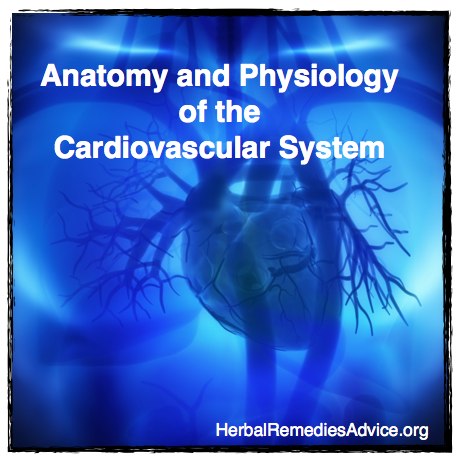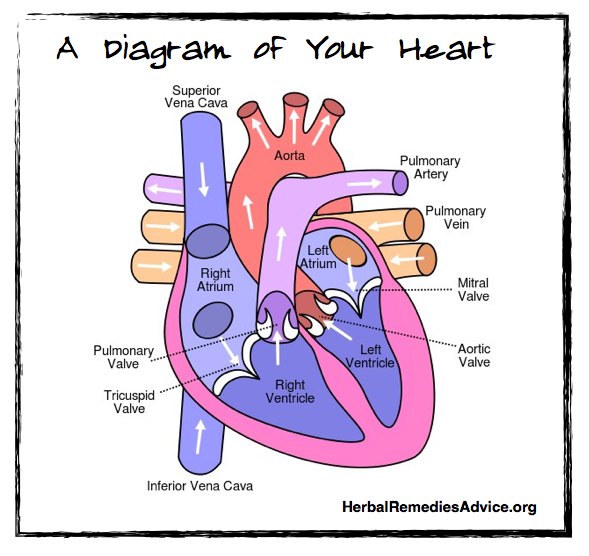Get weekly tips, recipes, and my Herbal Jumpstart e-course! Sign up for free today.

Cardiovascular System Facts
Share this! |
|
The following article is a brief summary of cardiovascular system facts. It is designed to make you aware of how your body works so you can take better steps to naturally maintain a healthy heart.
Cardiovascular System Function
The cardiovascular system function is to deliver nutrient-rich blood throughout the body and remove naturally-occurring metabolic wastes from the body.
The cardiovascular system consists of:
Heart
Blood vessels including arteries, capillaries, and veins
Blood
The Heart
The heart is a muscular organ made up of involuntary striated muscle tissue. It is located in the thoracic cavity in between your lungs and just above the diaphragm.
On average the heart beats 72 times a minute for an adult. This means your heart beats 100,000 times a day and over 3 million times a year!
The heart is covered in protective membranes called the pericardium. Besides forming a protective layer, these membranes also secrete a fluid that helps to reduce friction as tissues rub together during heart contractions.
The next layer of the heart is a thick layer of cardiac muscle tissue called the myocardium. It is the contraction of the myocardium that creates the force necessary to pump blood through the body.
Attached to the outer surface of the myocardium is the epicardium. This membrane consists of blood vessels that nourish the heart.
The heart chambers
You have four chambers in the heart. The two upper chambers are called the atria. They receive blood from the veins. The two lower chambers are the ventricles. Blood is pumped from the ventricles to the arteries and to the rest of the body.
The heart valves
There are two types of valves located in the heart: the atrioventricular valves and the semilunar valves.
The sound we associate with the heartbeat is actually the closing of your heart valves. “Lub-dub” is the sound often used to describe the sound of the heartbeat. The first sound, “lub”, is the sound of your atrioventricular valves closing. The second sound, “dub”, is the sound of your semilunar valves. If any of your heart valves are not working correctly then another sound might be heard. This is referred to as a heart murmur.
Blood Vessels
There are three main types of blood vessels. Arteries, capillaries, and veins form a system of tubes that carry blood to and from the heart. The blood vessels form an incredible network of tubes throughout the body. An adult has as many of 100,000 miles of blood vessels in their body.
Arteries
These large blood vessels are made of a thick muscular layer to withstand higher blood pressure. They carry blood from the heart to the capillaries.
Capillaries
Capillaries form a vast network of very small vessels that enable the exchange of materials between blood and the tissue cells. The term capillary bed refers to a network of capillaries that supply blood to an organ.
Veins
Veins return blood from the capillaries back to the heart. They are made up of a relatively thin muscular layer and contain internal valves to keep the blood from ever flowing backwards. About 60% of the blood volume is located in the veins at any given time.
Blood
When a baby is born it has about one cup of blood in its whole body! The
average adult has anywhere from four to five quarts in their body.
About 8% of your body weight is blood.
Blood is a specialized fluid in the body with several important roles:
- It transports nutrients to the cells in your body (including oxygen, glucose, amino acids, blood lipids)
- It transports waste materials from cells to your elimination organs such as the liver, kidneys, and lungs
- It supports your immune system function by circulating white blood cells and detecting pathogens with antibodies
- It transports hormones
- It regulates your core temperature
- It regulates pH balance
- It coagulates to help the body heal cuts and other wounds
Blood is made up of cells suspended in a liquid we call plasma. Plasma accounts for 54.3% of blood volume. Cells that are suspended in plasma include:
Blood flow
Deoxygenated blood from the body flows from the superior and inferior vena cava veins to your right atrium. This blood is pumped to the right ventricle and then proceeds to the pulmonary trunk where it is oxygenated by the act of inhalation. This newly oxygenated blood then flows through pulmonary veins to the left atrium and is pumped to the left ventricle to continue to the aorta and the rest of the body. These are referred to as the pulmonary and systemic circuits.
Blood pressure
The circulation of blood throughout the body happens due to changes in blood pressure. Blood naturally flows from areas of high pressure to areas of lower pressure. When the ventricles contract the pressure necessary to push the blood into the arteries is created. As the blood travels throughout the body the pressure continually decreases.
Red blood cells (Erythrocytes)
Red blood cells make up 45% of the volume of blood. Red blood cells contain hemoglobin. Hemoglobin contains iron, which binds with oxygen and is responsible for the red coloration of the blood. The primary role of red blood cells is to transport oxygen from the lungs to the rest of the body.
White blood cells (Leukocytes)
About .7% of the blood is made of white blood cells. White blood cells are primarily a function of the immune system. They remove old cells and are an important line of defense against pathogens.
Platelets (Thrombocytes)
Platelets help to coagulate the blood.

Rosalee is an herbalist and author of the bestselling book Alchemy of Herbs: Transform Everyday Ingredients Into Foods & Remedies That Healand co-author of the bestselling book Wild Remedies: How to Forage Healing Foods and Craft Your Own Herbal Medicine. She's a registered herbalist with the American Herbalist Guild and has taught thousands of students through her online courses. Read about how Rosalee went from having a terminal illness to being a bestselling author in her full story here.

